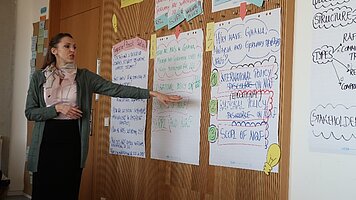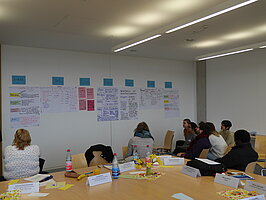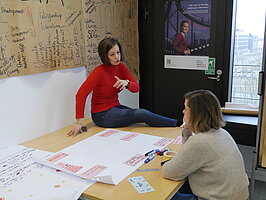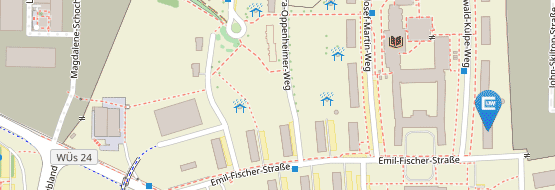Design Thinking



Aim of the strategy/method
- to use the critical capacity of the mind;
- to create the condition for innovation thinking;
- to share knowledge with others;
- to learn creative processes with and from others;
- to know the power of empathy.
A design mindset is not problem-focused, it is solution-focused and action-oriented. Design thinking involves both analysis and imagination.
Setting
- Palestra di intraprendenza / Entrepreneurship Gym
Type and name of the course, curriculum, number of students
- Entrepreneurship Gym is a learning service of the University of Florence’s career service.
- The number of students was around 170 (2018) and 80 (first part of 2019).
Description of the method/strategy
Everyone has the capacity to be creative. It is important for everyone to develop their own creative potential.
Stanford’s design thinking model:
The most important points (Nielsen & Stovang, 2015):
1. Empathize: The problem is considered using both an emotional approach and a rational approach, individually. In this first section, every student/participant is part of analysing needs and developing a deep empathic understanding of the user’s needs and context.
2. Define: The formation of heterogeneous teams; in this phase, the team begins to define the number and type of members. They begin to imagine and create the vision of the problem.
3. Ideate: Dialogue-based conversations are the most important technique of this part; at the same time, research based on interviews, focus groups, or semi-structured questionnaires is used.
4. Prototype: The team begins to prototype the solution by process or by product. This session is the action part of the entire process.
5. Test: The use of a structured and facilitated process is put in front of the team. In this session, the team thinks of every possibility to make the process of research more structured and more sustainable.
In synthesis:
1. Put the challenges in front of the students.
2. The students choose one challenge.
3. The students begin to work on the problem: They must have a solution at the end of the experience.
4. The team interviews the principal stakeholder in order to have some terms of comparison and other types of vision to be able to put the original problem in perspective.
6. After the interview, the students begin to reflect on the original problem once again.
7. The student team tries to design a solution to the problem.
8. The student team works to finalise the process with a pitch instrument.
A sample application from the 2020 International Winter School:
The 2020 International Winter School in Würzburg adopted design thinking as a strategy to moderate the comparative group ‘Entrepreneurship in higher education for the development of innovation and creative thinking’.
Links were identified between design thinking and the comparative method, as shown below:
Design Thinking | Comparative method | Description |
Empathize | Share country report | In this first phase, participants presented their transnational essay, sharing the identified definitions of entrepreneurship education. Practitioners explained what it means to teach about creativity in their professional context and what an adult educator can do with creativity. |
Define | Identify similarities, differences, comparative categories. Juxtaposition and interpretation | Moderators shared with participants the theoretical framework of the comparative group, explaining the key features of entrepreneurship education and the design thinking method. Participants identified similarities, differences, comparative categories within their countries. Then the process of juxtaposition and interpretation was carried out. |
Ideate | Identify the research question and answer it | The ideate phase was characterised by finding answers that emerge from the research question identified below. |
Prototype | Design something new | During the prototype phase, students hypothesised a new educational programme in entrepreneurship education. |
Test | Present results and the new programme | The test phase consisted of the final pitch, dedicated to comparative groups and given by the students on the last day of the week. |
Materials required
- Post-it notes, Lego Serious Play (optional), tables, pptx
Origin and theoretical framework
- This method comes from Stanford University and was created by David Kelley and Tim Brown from IDEO. This is not just a method, it is a new vision of the creative process and the innovation process. It is based on problem solving and empathy competences.
- The method was created for companies to reach more solutions in a collaborative manner. We think that this method could be very interesting in educational settings, especially at the higher education level in the work-related process.
- See: IDEO (2019), Foundations in Design Thinking Certificate. Program Syllabus.
- See: Kristiansen, P., & Rasmussen, R. (2014). Building a better business using the Lego Serious Play Method. John Wiley & Sons.
- See: Naiman, L. (2019). Design thinking as a strategy for innovation. The European Business Review, May–June 2019.
Risks and advantages
- Risks: Given that this is a very interactive method, it is very important to know interpersonal and communication strategies;
- Advantages: It is a great method for implementing the creative process and for reaching an innovative mindset.
The method is highly transferable. Over the past 20 years, design thinking has been spreading around the world. It is unknown in Europe, but in the Anglo-Saxon countries, it has reached wide diffusion.
Linda Naiman (2019) says:
SAP has identified four critical success factors when implementing design thinking:
1. Leadership: Link design thinking initiatives to your strategic goals. Provide direction, resources, and commitment.
2. People: Enable champions to lead the change through successful lighthouse projects. Build up an internal design thinking community where best practices are shared.
3. Process: Use the generic design thinking framework but evolve the method and tools so they support your company’s objectives.
4. Environment: Develop and create collaborative workspaces for your workforce. Use to co-innovate with your customers and partners (Neiman, 2019).
Possible variations
I used this method in the last three years with about 400 students from the University of Florence’s master’s degree courses.
My entrepreneurship team uses this method on different types of challenges in different types of situations, e.g. with real problems and challenges (GKM driveline; Eli Lilly Company; Terre dell’Etruria Social Cooperative (Livorno – Italy); Legacoop Amiatina (Legacoop Toscana – Firenze) and Comune di Castel del Piano (Grosseto), or in university situations with university challenges.
Other examples where you think it could be used
In companies
Recommendations
The diffusion of the method: It is important to study this method from an educational point of view and from a pedagogical point of view. There is a lack of scientific studies on the didactical and educational points of view.
Annexes
- See: Hasso Plattner, Institute of Design at Stanford (2019), An introduction to Design Thinking PROCESS GUIDE (06/2019).
Name of the file: ModeGuideBOOTCAMP2010L.pdf
References
IDEO (2019), Foundations in Design Thinking Certificate. Program Syllabus.
PDF available here: (06/2019).
Hasso Plattner, Institute of Design at Stanford (2019), An introduction to Design Thinking PROCESS GUIDE
PDF available here:
Kristiansen, P., & Rasmussen, R. (2014). Building a better business using the Lego Serious Play Method. John Wiley & Sons.
Nielsen S. L., & Stovang, P. (2015). DesUni: University entrepreneurship education through design thinking. Education + Training, 57(8/9), 977–991.
Naiman, L. (2019). Design thinking as a strategy for innovation. The European Business Review, May–June 2019.
Terzaroli, C. (2019). Educating creativity: An entrepreneurship program in higher education. Rivista Formazione, Lavoro, Persona, 9(27), 70–86.
Contact Person
Vanna Boffo ( vanna.boffo@unifi.it )


